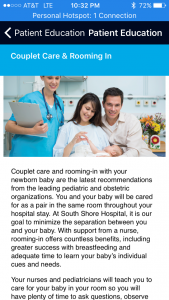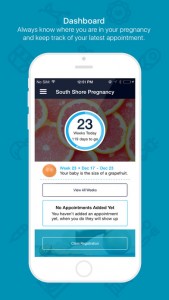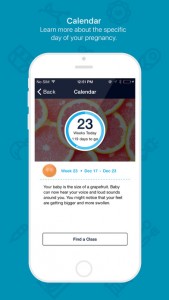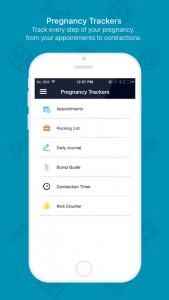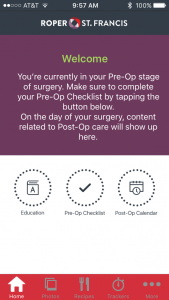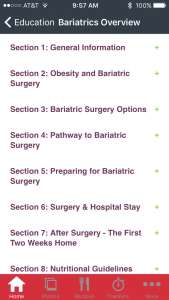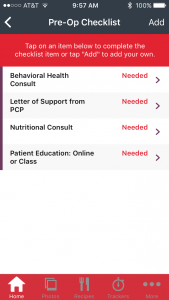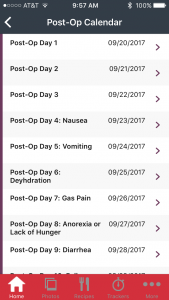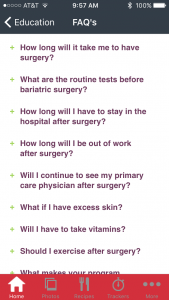Goodbye, Bulky Patient Handbooks; Hello, Service Line Apps
eHealthcare Pulse
// By Jane Weber Brubaker //
Printing patient education pamphlets, brochures, and information kits isn’t cheap. It’s one thing if patients actually use them. But do they? Two hospitals thought mobile apps might be a better solution.

Luke Poppish, executive director of the OB/GYN service line at South Shore Hospital
Luke Poppish is executive director of the OB/GYN service line at South Shore Hospital near Boston, Massachusetts. “Anecdotally, we were hearing that moms would get their information booklet at their intake appointment, and they would throw it in a drawer, leave it on a table, anywhere but being useful,” he says. “Our supposition was, can we stop giving out all these handouts and pamphlets and printouts if we consolidate all that information and put it on an app?”
Roper St. Francis Hospital in Charleston, South Carolina had a similar situation, but with a different service line: bariatrics. “Bariatrics is a long lead-time surgery, and it requires a lot of information,” says Krista Robertson, interactive marketing manager. “Patients have this enormous, thick patient handbook, and the bariatrics team wanted a way that they could provide that content in an easier, more digestible manner.”
Both organizations had lean teams and limited budgets. Instead of trying to build apps from scratch, they opted to collaborate with a mobile application platform vendor that touts “code-free mobile app development.” The apps successfully launched earlier this year.
Besides reducing print costs, the app strategies employed by these two organizations achieved positive results for other strategic objectives.
South Shore Hospital’s Challenge
South Shore Hospital’s five affiliated OB/GYN practices operated independently of one another, each with its own unique culture. There was no consistency to messaging, and patients could easily get different information about what to expect during labor and postpartum, or during their hospital stay. Sometimes the information even varied from physician to physician within the same practice.
Poppish discussed the situation with the chair of OB/GYN. “We talked about what we could do to have a single source of truth for all of the moms in our community regardless of which practice they chose,” he says. An app seemed like the right path, but where to start? A Google search on pregnancy apps led him to the UCLA Baby app (Platinum winner, eHealthcare Leadership Awards, 2015), and ultimately to app developer MobileSmith.
Outsourcing Development Is Key
“I worked with people internally to figure out what was the quickest way to get this thing to launch with the fewest barriers possible, knowing how many barriers exist in healthcare,” says Poppish. The IT department gave MobileSmith’s solution the go-ahead because it didn’t require any IT resources to implement or maintain. There were no HIPAA issues because the patient’s due date is the only information captured in the app. Next, Poppish consulted with marketing. He agreed to adhere to established brand standards, and got approval to run with the project.
Blueprint for Success
The app development was expedited through MobileSmith’s “Hospital App Blueprints” program, which uses existing templates as the core, and customizes other elements such as hospital-specific information. “We tweaked the overall aesthetics, the look and the feel, and we moved some stuff around, as much as the platform would allow us,” says Poppish. “We modified monthly and weekly check-in tips based on feedback from midwives, mid-levels, nurses, and OB/GYNs to shape what we thought patients should know about in a given month or week based on their gestational age.” An FAQ page links to ACOG (the American Congress of Obstetricians and Gynecologists), connecting app users to the latest information from an external authority. The app also contains educational information about unique aspects of maternity care at SSH, such as couplet care and rooming in.
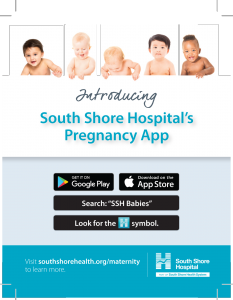
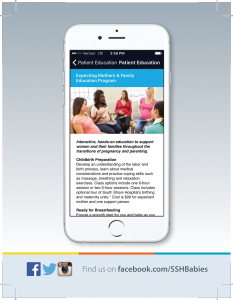
“I get many more requests for more app cards to give patients than I do the packets,” says Poppish. “Our goal by the end of a full year was to have 50 percent of moms on the app instead of the packet. I think we’ll get to it—if not exceed 50 percent.” He estimates that 1,700 to 1,800 patients will opt to download the app and forego the packet by year-end.
Launching an App on a Shoestring
Roper St. Francis didn’t have a specific service line in mind when it made contact with MobileSmith, impressed by its approach to app development, which didn’t require internal IT resources. “We share a web developer with IT and the rest of the health systems,” says Robertson. “We were trying to figure out how we could get into the world of apps with our small resources and our limited budget.”
Robertson set up an internal process to solicit and vet ideas from service lines. “They have to meet certain criteria,” she says. “It has to tie back to one of our overall strategic initiatives and solve a problem or an issue. Then let’s look at if an app strategy will work for you.”
Bariatrics Looks for a Better Way
Bariatrics had a compelling use case, and a pilot was conceived. “Bariatrics is a little bit different from a typical surgery. There’s lots of information that the patient needs to know upfront, and milestones they may have to meet before they can actually qualify for surgery,” says Robertson. “[Bariatrics] wanted a better way to have patients manage their own milestones and keep track of their progress.”
The app they envisioned would help patients stay on track with notifications and reminders at key times, ultimately resulting in more successful surgeries, and in the interim, the information in the app would cut down on calls to the office, and reduce the need for the printed patient handbook.
The service line was involved throughout the process. “They obviously are the experts, and so we had our marketing team, the service line, and MobileSmith all working together until launch,” says Robertson. There was no existing “blueprint” for bariatrics, and the app was developed from scratch.
The app populates all scheduled milestones based on the patient’s surgery date; if the surgery date changes, the dates automatically adjust.
Features of the app include:
- Overview of surgery
- Pre-op checklist
- Post-op checklist
- FAQs
- Recipes and nutritional information
- Exercise recommendations
- Weight and appointment trackers
- Photos
- Link to closed patient-only Facebook group
- Pop-up reminders and notifications
The patient-only Facebook page was created several years before the app launched, and offers a community experience for patients to compare notes and share ideas. “It is not a place where we give clinical information at all,” says Robertson.
Finish the “Prescription” — Then Delete It
The app, RSF Bariatrics, launched in March. It is prescribed during office visits, where patients get help accessing and downloading it. If patients choose the app, they do not receive the printed patient handbook, but it is still available for those who prefer it. “We have about 159 users, and we’re pleased with those results thus far,” Robertson says. She does not envision large numbers of users for this type of service line focused app. “We aren’t expecting users to keep the app indefinitely on their phones. It serves a specific purpose, and when they’re done with that purpose, they delete it.”
Trend: Streamlined Apps for Specific Problems
Robertson observes that service line focused apps may be more effective than a one-size-fits-all health system app. “You’re battling for people to take up space on their phone for an app that they might use every six months to a year,” she says. “That mentality has shifted to very streamlined, specific apps that solve a specific problem, improve a process, or help with patient experience overall.”
Robertson sees an opportunity to impact same-day surgery cancellations through an app. “People eat past the time that they’re supposed to, so why not build in those notifications that go straight into their phone that say ‘This is your last chance to eat. Eat now!’”
Both organizations valued the collaboration they had with MobileSmith. “Their platform and their team have been super helpful,” Robertson says. “Their team was really integral in helping us through the entire conceptualization of the app.” Poppish was delighted with the speedy development and implementation process using the Blueprints service. “It was crazy how fast they turned it around,” he says. The contract was signed in October, and the app launched in December.
Jane Weber Brubaker is a contributing editor at eHealthcare Strategy & Trends, and chair of the eHealthcare Leadership Awards.


